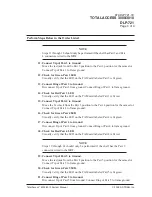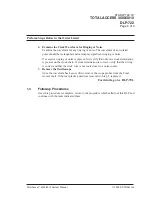
Total Access
®
3000/3010 System Manual
6TADLP722-1E
TOTAL ACCESS 3000/3010
DLP-722
Page 2 of 4
© 2002, ADTRAN, Inc.
Perform Steps Below in the Order Listed
1.2
Detailed Level Procedure 722
1.
Set Up the Oscilloscope
Place the oscilloscope in a position so that the probes can be readily attached to the
rear of the Total Access shelf. Power up the oscilloscope and attach the two
probes.
This procedure requires that the rear plastic guard be removed.
2.
Connect the Scope to the Composite Clock Input
Connect one scope probe to the “+” wire-wrap pin of Connector P4 (EXTCLK A-
IN). Connect the other probe to the “-” wire-wrap pin of the same connector.
3.
Configure Scope to Display Differential Voltage
Configure the scope to display the voltage difference between the two probes.
Adjust the time and voltage scales to correctly display the waveform. The
waveform should be a square wave with a 5/8 duty cycle.
4.
Examine the Clock Waveform for Peak Voltage
Examine the waveform to determine the peak voltage. If the peak voltage is less
than 2.7 V or more than 5.5 V, then the clock signal does not meet specifications.
If a problem exists, verify that the number of loads on the clock chain is equal to
or less than the maximum number supported by the clock source.
If the number of loads is within spec, check the length of the cable run to ensure
that they do not exceed the maximum allowed for the cable type. If the cable is
within spec, verify that only one clock termination is present on the clock chain.
5.
Examine the Clock Waveform for Rise and Fall Time
Examine the waveform to determine the rise and fall time. Verify that the rise and
fall time is less than 0.5 microseconds.
If a problem exists, verify that the number of loads on the clock chain is equal to
or less than the maximum number supported by the clock source.
If the number of loads is within spec, verify that only one clock termination is
present on the clock chain.






























